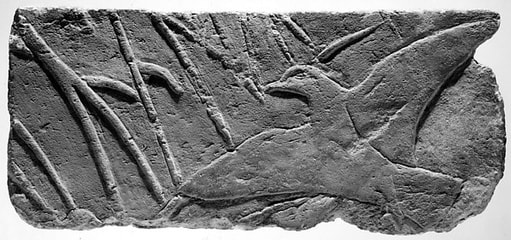ibis
1. In France or London, the sibilant machine of SCIENCE invents a bird
based on the relics of Egyptian monuments, which is not an exact copy of Nature.
2. Fragments of amber rewoven into the composite IMAGE, is also an invitation
to form SOUND, the whistle of species placed in a jar.
3. The jar is the ART of categories, the essential basis of our condition — to not look away but
to look in wreaths, full blown, to sow our reflection as an exact copy of Nature.
4. According to Herodotus there are two kinds of ibis: black and white, the black is the enemy
of serpents, the white is a domestic bird. The afterlife is a house not all birds are allowed in.
5. The best-preserved birds are found in the mummies of Saqqara, wrapped in dyed linen, then
sawed open. Tools dressed in membrane correct myth: there were shellfish in the cavities,
not snakes.
6. In order to preserve SCIENCE, the language of speculums rusting by the window,
we must shake the graves of birds.
7. Shaking graves is not a species complex; which is actually an argument of resemblance,
a market for more skin.
8. Precise methods of dissection are also useful when carving the womb out of a woman’s corpse.
We draw this jar to reproduce ourselves, in order to keep producing the SCIENCE of birds.
Bodies are families, bred of facts and secrets waiting to become facts.
9. She who scrivens — do you contain a monster nostalgia? keep keep keep keep keep
10. Years from now, when sliced open to be redrawn from memory, the naturalists discover
an engraving in the urn of my skull: “play dead” (and a laugh track).
based on the relics of Egyptian monuments, which is not an exact copy of Nature.
2. Fragments of amber rewoven into the composite IMAGE, is also an invitation
to form SOUND, the whistle of species placed in a jar.
3. The jar is the ART of categories, the essential basis of our condition — to not look away but
to look in wreaths, full blown, to sow our reflection as an exact copy of Nature.
4. According to Herodotus there are two kinds of ibis: black and white, the black is the enemy
of serpents, the white is a domestic bird. The afterlife is a house not all birds are allowed in.
5. The best-preserved birds are found in the mummies of Saqqara, wrapped in dyed linen, then
sawed open. Tools dressed in membrane correct myth: there were shellfish in the cavities,
not snakes.
6. In order to preserve SCIENCE, the language of speculums rusting by the window,
we must shake the graves of birds.
7. Shaking graves is not a species complex; which is actually an argument of resemblance,
a market for more skin.
8. Precise methods of dissection are also useful when carving the womb out of a woman’s corpse.
We draw this jar to reproduce ourselves, in order to keep producing the SCIENCE of birds.
Bodies are families, bred of facts and secrets waiting to become facts.
9. She who scrivens — do you contain a monster nostalgia? keep keep keep keep keep
10. Years from now, when sliced open to be redrawn from memory, the naturalists discover
an engraving in the urn of my skull: “play dead” (and a laugh track).
|
Relief with a bird, ca. 1353–1336 B.C. Egypt. Limestone and paint. The Metropolitan Museum of Art.
|
Zaina Alsous is the author of the chapbook Lemon Effigies (Anhinga Press). Her first full-length collection A Theory of Birds will be published by University of Arkansas Press in fall of 2019.

